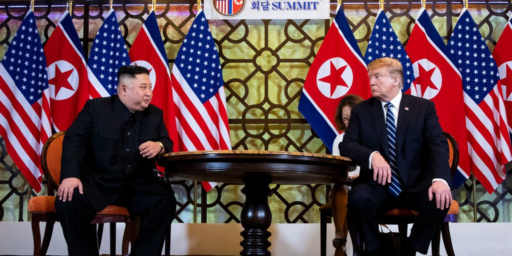An Alternate Plan for Missile Defense
This morning in an op-ed in the New York Times MIT prof Theodore Postol proposes an approach towards defending against missile attacks from Iran or North Korea that there are reasons to believe would be acceptable to Russia:
President Obama has correctly shown skepticism about the missile defense system promoted by the Bush administration: its performance is unproven, it requires unending additional resources and it faces problems that cannot be solved with existing science. Russia, for its part, has long perceived missile defense as a threat to its security — a concern the administration chose to ignore, worsening tensions with Moscow.
Fortunately, there is a “designer” missile defense that would answer President Obama’s hesitations and allay Russia’s fears. And unlike the Bush missile defense, it would actually be able to deal with the threat of ballistic missile attacks from North Korea and Iran if such a threat ever emerged.
This is a proposal I’ve developed and analyzed with a variety of American and Russian experts and the idea itself is simple. The defense system would shoot down Iranian or North Korean long-range missiles as they slowly accelerate from their launching sites. It would take advantage of the fact that long-range missiles built by Iran or North Korea would be large and cumbersome, have long powered flight times and could take off only from well-known launching sites.
The defense would have fast-accelerating interceptors that could home in on and destroy the large, slow and fragile ICBMs. The interceptors would weigh about a ton and could achieve a top speed of five kilometers per second in tens of seconds. They would be carried by stealthy unmanned airborne vehicles that look like B-2 bombers, but are smaller and carry much smaller, though still substantial, payloads. Such vehicles already exist.
Only two of these armed drones, controlled by remote teams of operators, would be needed to patrol within several hundred kilometers of a launching site. At these ranges, it would be possible to shoot down an ICBM, with its nuclear warhead, so that the debris falls on the territory of the country that launched it. Only five drones would be needed to maintain a continuous patrol for extended periods. But the system would have to operate only when satellites and reconnaissance aircraft indicate that an ICBM is being prepared at the launching site.
While this sounds to me like an eminently effective and practical plan, the question that it raises in my mind is would implementing such an approach for Iran and North Korea be stabilizing or destabilizing?
It seems to me that the answer depends on whether you think that Iran or North Korea are acting aggressively or reacting to perceived threats whether those threats really exist or not. If they are acting aggressively, although this missile defense wouldn’t eliminate their motivations for aggression it could well be an effective defense against that aggression. However, if the two countries are responding, however irrationally, to perceived threats wouldn’t moves towards an effective defense (especially one as cost-effective as this one sounds) further aggravate their feelings of vulnerability and being under attack?
Note that I don’t have ready answers to these questions only the questions and I’m prepared to listen to arguments either way.




The tests of the missile defense system in place seems to have worked pretty well so far, but detractor are willing to say something does not work when it does. Why would the United States care a whit about how the Russians feel about our defense? They can and have been a major contributor to the need for one. In a football game you do not ask the opposing team what player you should use against them. I believe it is the job the the United States government to protect this nation from threats, not re engineer social problems as they see fit with our tax dollars. When the Republicans take over in 2010, it will be Obama on the docket charged with treason and will be impeached. This jug eared lop is willing to spend billions for tribute and not a dime on defense. But elections have consequences.
For some reason or other the Russians become concerned when missiles are installed in the Czech Republic, Poland, or some other adjoining country that are pointing in their direction. Go figure.
I guess it depends on whether Iran needs ballistic missiles to hit Ghawar.
An Iranian bomb will destabilize an unstable region. First, Arab states will seek their own bomb. Second, there will be technology sharing issues with other states and non-state organizations. Third, as mentioned above, U.S. interests can be harmed by other means of conveyance.
You’d have to keep aircraft in the air 24/7 for this to work, how is that practical? At least with Bush’s system, its operating costs where minimal when it wasn’t in use. I also don’t see how missiles in drones would concern Russia less than missiles on the ground.
Those missiles couldn’t do much to Russia, except intercept their missiles. They didn’t pose a danger to Russia, they just decreased it’s offensive potential, which is what Russia found threatening.
I think that Iranian nuclear weapons and defending against Iranian missiles are interrelated but different questions, PD. While I agree with your comments about the bad consequences of the present Iranian regime with nuclear weapons, I think it’s too late to do much about it now.
The topic of the op-ed was defense against Iranian missiles, the putative reason for our stationing a missile-defense program in the Czech Republic and Poland, rather than Iranian nuclear weapons.
I am skeptical of the claim, but the article did answer it.
Well, not exactly. It could be months between when a satellite detects activity at a launch facility, and when a launch actually happens. Heck, what if a launch doesn’t happen, how long do we keep these birds in the air?
The aircraft would also need to “patrol within several hundred kilometers of a launching site.” By point of reference, the distance from Baghdad to Tehran is about 700 kilometers. So the alternative requires the U.S. to deal with basing and fly-over issues in an inhospitable region.
“would be needed to patrol within several hundred kilometers of a launching siteâ€
Iran alone is over 600,000 sq miles. Then there is a matter of stationing these things somewhere near and possibly dealing with neighboring countries. If by what you mean by several is approximately 200 miles then there is possible countermeasure including shooting the drones down and setting up dummy sites. Yes the drones are stealthy but it is the Iranians which determine when the launch their missiles so they can wait until they find the drone. I’m not that convince that it would be that reliable. A nice Idea for another layer but layer is already being address in the current missile defense plan.
No, most of it’s detractors are willing to point out how easily defeated the system is no matter how well it works in tests. Any system cheaper to defeat then it is to maintain is useless …
If the Iranians and the North Koreans put their missiles inside silos or underground launch sites, there will be ZERO indicators of any preparation of a launch.
As far as the keeping aircraft within several hundred kilometers within the launch sites, the Russians have SAM systems (SA-10, SA-20, etc.) that can already go out several hundred KMs, and are developing even longer range and more lethal systems. They are selling these systems and the Iranians are said to be interested.
Guess I should have refreshed my page before posting. I didn’t mean to repeat PD comments.
How hard would the Iranian air force have to work to knock out one drone to open a window towards a target? For that matter, how hard would they have to work to knock down all 5 drones? What do we do if they start knocking down the drones on a regular basis? Declare war?
I’m assuming they’re liquid fueled rockets, and that the Iranians don’t have pipes from the fuel depots to the launch silos, so I’m guessing we’d see tanker trucks at the very least.
Michael
Why would you assume that?
Iran’s Shahab 2 is essentially the same as North Korea’s Taep’o-dong 2 which is a liquid-fueled missile.
Because the Shahab-3 is liquid fueled.
Liquid fueled missiles can be stored underground or in silos. We had liquid fueled Titan missiles on alert in hardened silos. The Russians have them in SS-18 and SS-19 ICBMs as well as their SS-N-23 SLBMs in submarines. If the Iranians and North Koreans can develop ICBMs, they can certainly build silos or underground launch facilities to protect them. It all depends on their needs.
Right, but are they likely to be kept fueled at all times? Even still, doesn’t the fuel have to be cycled out periodically?
Michael – SCUDs (and the Nodongs, Shahabs, and all their derivatives) use storable propellants. That means they can be fueled and kept in storage for an extended period of time. If underground facilities are built, they can keep the fueled missiles inside them, and occasionally swap them out to change propellant onsite or at another location. But if they want to launch, we will receive little or no warning of such intentions.
Ah, there’s the part I was missing.
Maybe they’re suggesting we’ll know when they transport the missiles to the silos? Seems even less practical, then, to keep drones in the air waiting for something to happen.
Micheal
OK I should have specified your assumption of
“and that the Iranians don’t have pipes from the fuel depots to the launch silosâ€
How did I know you would only pick out the assumption that you could explain and not the assumptions that you couldn’t.
The Syrians have been making progress in solid fuel missiles which wouldn’t be hard to transfer to the Iranians. Granted it would be used for Medium range missile that woould not reach US but could be targeted at US interest elsewhere. This brings up another possible hostel country. It is foolish to assume that other countries technology will stay as it exists today.
It’s too loose of a probability that we will be guaranteed of prior knowledge about a launch. So that means that we’ll need to keep these aircraft up in the air 24/7. The price on that is insignificant compared to the after-effects of a launch, however the professor too easily dismisses everything that needs to come together for this.
To make this program viable, there needs to be a variety of system put together, he may say it’s all developed, but its definitely no comparison to some kind of parts bin.
The aircraft the professor is referring to is either the x45 or the x47 in all likelihood.
I addressed the assumption that I thought had the least amount of obvious support. I actually chose the assumption that I had the weakest explanation for.
But, you want to know why I assumed that the Iranians didn’t pipe rocket fuel from a processing plant many miles away? Simple: it’s an expensive, stupid and dangerous thing to do.
And storing it on site never cross your mind? Do we store ours only at our processing plant? Of course not.
I thought the assumption of liquid fuel rockets was the most obvious but understand how someone could assume that others don’t know much about such things. Still you should explain all your assumption. If any of your assumption breaks down then your whole theory would break down.
I didn’t think long-term storage of liquid rocket fuel was an option at the time, DC Loser has since educated me on that.
Fair enough